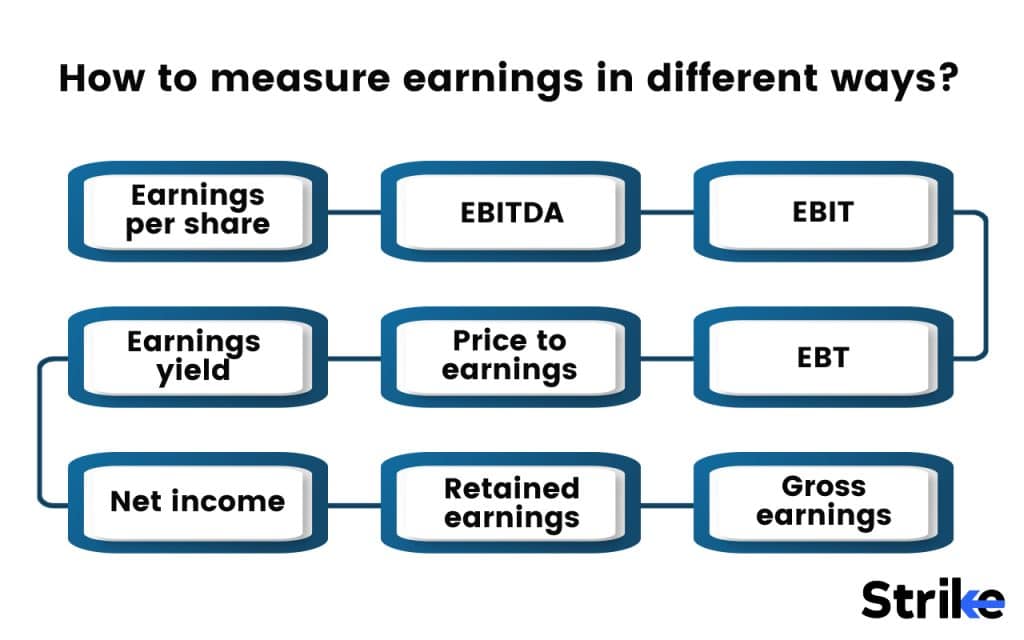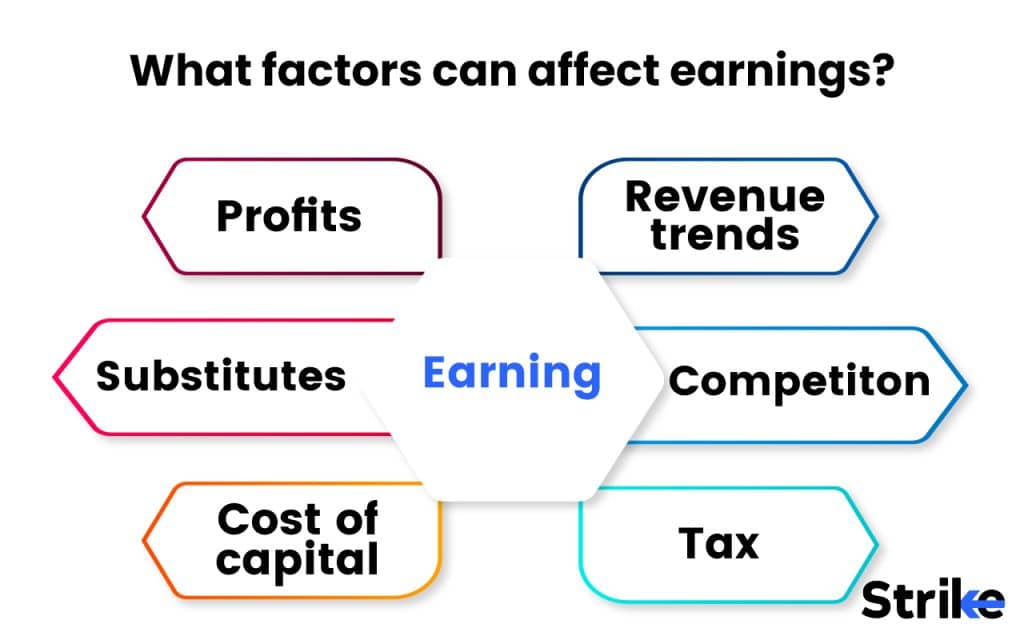Earnings: Definitions, Usage, Formula, Measurements, Example, Factors, Limitation

Earnings are one of the most important metrics for investors to analyze when evaluating publicly traded companies. As the bottom line figure that represents a company’s overall profitability, earnings provide critical insights into how well the business is performing financially. Every quarter, leading companies across various industries disclose their most recent earnings results, giving shareholders and analysts a key update on the organization’s revenue, costs, margins, and overall net income.
Earnings reports often drive significant movements in a company’s stock price as the market reacts to whether results met, beat, or missed expectations. Beyond just looking at the headline earnings number, savvy investors examine trends in metrics like earnings per share, revenue growth rates, profit margins, and operating cash flow to gain a more comprehensive view of a company’s true financial health and stability over time. As the lifeblood of any business, sustained earnings growth is what ultimately fuels increases in shareholder value and stock prices in the long run.
What are earnings?
Earnings represent the bottom-line financial performance of a business after accounting for all revenues, costs, taxes, interest, depreciation, and other expenses. Earnings are calculated by subtracting total operating costs and expenditures from total revenues and sales over a given reporting period, usually a quarter or fiscal year. Earnings provide concrete evidence of a company’s profitability and ability to generate returns for shareholders.
What are the usages of earnings?
Earnings reports provide critical insights into a company’s financial performance, enabling investors to analyze growth trends and valuations to make informed investment decisions in the stock market. Earnings reports, such as quarterly or annual earnings, provide critical information to investors about the financial performance and health of a company. Investors closely analyze metrics such as revenue growth, profit margins, earnings per share, and cash flows when earnings reports are announced to determine the company’s strength and outlook.
Significant changes in earnings versus expectations tend to move stock prices sharply in reaction. As such, earnings announcement days tend to see high trading volumes for stocks as investors rush to buy or sell based on the results. Earnings trends over successive quarters and years are examined by investors and analysts to gauge the growth trajectory and consistency of a company’s performance. Earnings growth is a key factor that drives up the valuation multiples and stock prices of companies in the long run. Lack of earnings growth sometimes points to problems in the company’s business model or management. Investors tend to favor stocks with strong and accelerating earnings growth.
The price-to-earnings (P/E) ratio is one of the most widely used stock valuation tools. It measures the current share price relative to the per-share earnings of the company. Comparing P/E ratios within sectors allows investors to identify relatively undervalued or overvalued stocks. Earnings also form the basis for calculating other useful ratios like the PEG ratio, which incorporates future earnings growth estimates.
What is the formula of earnings?
One of the most widely used earnings metrics is earnings per share (EPS). This measures a company’s net Profit allocated to each outstanding share of its common stock. The formula for calculating EPS is as stated below.
EPS = (Net Income – Dividends on Preferred Stock) / Average Outstanding Shares
The net income is the total earnings figure reported by the company. Preferred dividends are subtracted because preferred shareholders have a higher claim on dividends than common shareholders. The remaining net income is then divided by the average number of shares outstanding during the period.
EPS provides investors with a standardized way to compare profitability across different companies. A higher EPS generally indicates greater value creation and is preferred by investors. However, EPS can be manipulated through share buybacks, which reduce the denominator and boost EPS artificially. Investors should also analyze revenue growth, profit margins, and cash flows along with EPS to get a holistic view.
One of the most widely used stock valuation measures is the price-earnings ratio or P/E ratio. It is calculated by dividing the current market price per share by the EPS.
P/E Ratio = Share Price / Earnings Per Share
The P/E ratio reveals how much investors are willing to pay for each dollar of the company’s earnings. A high P/E suggests that investors expect higher growth from the company in the future. However, an extremely high P/E ratio sometimes also implies that the stock is overvalued. A low P/E indicates that the stock is sometimes undervalued or that the company is doing exceptionally well in the present. Comparing P/E ratios within an industry provides insights into relative valuations.
Earnings growth measures the percentage change in EPS over a given period of time, usually annually.
Earnings Growth = (Current Year EPS – Previous Year EPS) / Previous Year EPS
Steady earnings growth signals a company’s strong fundamentals and improving profitability. Rapid growth is attractive but possibly unsustainable in the long run. Flat or negative growth is a red flag for investors. Earnings projections and estimations by analysts are also critical in evaluating future growth potential. Companies with higher earnings growth tend to perform better in the stock markets.
The net profit margin demonstrates a company’s profitability after accounting for all expenses. It is expressed as a percentage and determined by the formula as stated below.
Net Profit Margin = Net Income / Total Revenues
This ratio quantifies how much of each rupee earned in revenue is translated into profits. A higher net margin reflects greater efficiency in cost controls and is more favorable. Comparing net margins over time highlights whether a company is becoming more or less profitable. Industry average margins provide a relative benchmark for evaluation.
Return on equity (ROE) is a popular profitability metric that calculates how efficiently a company generates profits from its shareholders’ equity. The formula for ROE is as stated below.
ROE = Net Income / Shareholders’ Equity
Shareholders’ equity represents the assets attributable to common shareholders. ROE measures how well a company utilizes this capital to generate additional net income. A higher ROE indicates greater profits earned from invested shareholder capital. Investors prefer companies with strong and rising ROEs over time. However, an overly high ROE signals excessive financial leverage and risks.
How do we measure earnings in different ways?
Different ways to measure earnings are Earnings per share, EBITDA, EBIT, EBT, Price to earnings, Earnings yield, Net income, Retained earnings, and Gross earnings.

1.Earnings per share
Earnings per share (EPS) is a financial ratio that measures the portion of a company’s net Profit that is allocated to each share of its common stock outstanding. It is one of the most widely used metrics to gauge a company’s profitability on a per-share basis. The formula to calculate EPS is as stated below.
EPS = (Net Income – Preferred Dividends) / Average Outstanding Shares
Where Net Income is the total profits earned by the company during the period, preferred Dividends are the dividend amounts paid to preferred shareholders. Average Outstanding Shares is the weighted average number of common shares outstanding during the period.
For example, if a company has a net income of Rs 100 crore for the fiscal year, Rs 10 crore of preferred dividends, and 50 crore average outstanding shares, then its EPS would be as given below.
EPS = (100 – 10) / 50
= 90 / 50
= Rs 1.8
This means the company has earned Rs 1.8 of Profit for each of its 50 crore outstanding shares.
2. EBITDA
EBITDA stands for Earnings Before Interest, Taxes, Depreciation, and Amortisation. It is a measure of a company’s operating performance and profitability before factoring in non-core expenses. EBITDA is widely used by investors in the Indian stock market to evaluate and compare companies, especially across the same industry. The formula for EBITDA is as stated below.
EBITDA = Net Revenue – Operating Expenses (excluding interest, taxes, depreciation, and amortization)
Net Revenue is total revenues minus costs directly related to generating those revenues. Operating Expenses are day-to-day expenses for running the company, such as employee wages, raw material costs, marketing, and rent.
For example, a company has a net revenue of Rs. 500 crores and employee costs of Rs. Fifty crores, raw material costs of Rs. One hundred crores and marketing costs of Rs. 150 crores, its EBITDA would be as given below.
EBITDA = Rs. 500 crores – (Rs. 50 crores + Rs. 100 crores + Rs. 150 crores)
= Rs. 500 crores – Rs. 300 crores
= Rs. 200 crores
In this example, the company’s core operating profitability is Rs. 200 crores for the period. Interest, taxes, depreciation, and amortization expenses are excluded.
3. EBIT
EBIT stands for Earnings Before Interest and Taxes. It measures a company’s operating profitability, excluding the expenses of interest and taxes. EBIT is a key metric used by investors in the stock market to evaluate the core earnings potential of a company. The formula for EBIT is as stated below.
EBIT = Revenue – Operating Expenses (excluding interest and taxes)
Revenue is the total income earned by the company from business activities.
Operating Expenses are the day-to-day expenses related to running the business operations, such as employee wages, raw material costs, marketing expenses, etc.
For example, a company has revenue of Rs. 1000 crores, operating expenses of Rs. 700 crores, interest expense of Rs. 80 crores and tax expense of Rs. 100 crores, its EBIT would be EBIT = Rs. 1000 crores – Rs. 700 crores
= Rs. 300 crores
Here, the company’s core operating profit before accounting for interest and taxes is Rs. 300 crores.
4. EBT
EBT stands for Earnings Before Taxes. It measures a company’s profitability after accounting for all operating expenses but before factoring in tax expenses. EBT is an important metric used by investors in the stock market to evaluate profitability. The formula for EBT is as stated below.
EBT = Revenue – Operating Expenses – Interest Expenses
Revenue is the total income earned from business activities. Operating Expenses are day-to-day expenses related to running operations. Interest Expenses are the cost of interest on debt capital.
For example, a company has revenue of Rs. 1000 crores, operating expenses of Rs. 600 crores, and interest expense of Rs. 100 crores, its EBT would be as stated below: EBT = Rs. 1000 crores – Rs. 600 crores – Rs. 100 crores
= Rs. 300 crores
Here, the company’s operating profitability after accounting for interest costs but before taxes is Rs. 300 crores.
5. Price to earnings
The Price to Earnings ratio (P/E ratio) is one of the most commonly used valuation metrics by investors in the Indian stock market. It shows the relationship between a company’s market price per share and its earnings per share (EPS). The formula for calculating the P/E ratio is as stated below.
P/E Ratio = Market Price per Share / Earnings per Share
For example, if a company’s share price is Rs.100, and its EPS is Rs.10, then its P/E ratio is 10 (100/10).
A high P/E ratio generally indicates that investors are expecting higher growth and are willing to pay more for the stock. However, an extremely high P/E ratio sometimes also suggests the stock is overvalued. A low P/E ratio could mean the stock is undervalued or the company is doing poorly. The average P/E ratio varies by sector and market conditions.
Investors should compare companies within the same industry and examine other factors like earnings growth, competitive position, debt levels, etc., when evaluating P/E ratios. The P/E ratio has limitations, but when used along with other metrics, it provides a good starting point to assess stock valuations. Investors in the market routinely use P/E analysis to screen stocks for investment. However, each company’s situation is unique, and multiple factors should be considered when making investment decisions.
6. Earnings yield
Earnings yield is a valuation metric used by investors to compare the earnings of a company to its share price. It is calculated by taking the earnings per share (EPS) and dividing it by the market price per share. The formula for earnings yield is as stated below.
Earnings Yield = EPS / Market Price per Share
For example, if a company has an EPS of Rs.10, and the current market price is Rs.100 per share, the earnings yield would be as stated below.
Earnings Yield = Rs.10 / Rs.100 = 0.10 or 10%
The earnings yield represents the rate of return on a share if all the earnings were paid out as dividends. It is the inverse of the price-to-earnings (P/E) ratio.
A high earnings yield indicates the stock is undervalued – the earnings are high compared to the share price. A low earnings yield signals overvaluation – the share price is high relative to the underlying earnings.
Investors use the earnings yield to identify value stocks that have higher earnings compared to the valuation. However, earnings yields should be compared for companies in the same industry due to differences in growth rates and payout ratios. It has limitations if used in isolation, so other metrics like revenue growth, debt level, and cash flows should also be considered while making investment decisions.
7. Net income
Earnings per share (EPS) is an important financial metric used by investors to assess a company’s profitability on a per-share basis. EPS measures how much net income a company has generated for each share of its common stock outstanding. The formula to calculate EPS is as stated below.
EPS = (Net Income – Preferred Dividends) / Average Outstanding Shares
Where Net Income is the total net Profit earned by the company during the period, preferred Dividends are dividend payments made to preferred shareholders. Average Outstanding Shares is the weighted average number of common shares outstanding during the period.
For example, let’s say a company has a net income of Rs 100 crore for the fiscal year, Rs 10 crore of preferred dividends, and 50 crore average outstanding common shares. Its EPS would be calculated as stated below.
EPS = (100 – 10) / 50
= 90 / 50
= Rs 1.8
This means the company has earned Rs 1.8 of Profit for each of its 50 crore outstanding common shares. A higher EPS generally indicates greater profitability and is looked upon favorably by investors in the stock market.
8. Retained earnings
Retained earnings refer to the portion of net income or Profit that a company retains after distributing dividends to its shareholders. It is an important component of shareholders’ equity on the balance sheet. The formula for calculating retained earnings is as stated below.
Retained Earnings = Beginning Retained Earnings + Net Income or Profit for the year – Dividends
For example, Beginning Retained Earnings = Rs. 500 crores
Net Profit for the year = Rs. 200 crores
Dividends = Rs. 50 crores
Retained Earnings = Rs. 500 crores + Rs. 200 crores – Rs. 50 crores
= Rs. 650 crores
Retained earnings are considered high-quality capital that can possibly be used to fund expansions, acquisitions, or pay off debt. It represents surplus profits reinvested in the company.
Investors look at the level of retained earnings to gauge how efficiently the company is deploying its profits. Higher retained earnings indicate the company is utilizing profits well for growth rather than excessive dividend payouts. However, very high retained earnings on the balance sheet could also mean inadequate returns for shareholders. As such, investors should analyze retained earnings trends over time rather than absolute levels.
9. Gross earnings
Gross earnings refers to a company’s total revenues before any deductions or expenses are accounted for. It represents the top-line earning capacity of a company before operating costs, interest, taxes, depreciation, etc. The formula for gross earnings is as stated below.
Gross Earnings = Total Revenue + Other Income
Where Total Revenue is the income earned from the company’s core business operations and activities, other Income is revenue earned from secondary activities like interest/dividend income, rental income, etc.
For example, if a company has total revenues of Rs.1000 crores from sales and other income of Rs.100 crores from investments, its gross earnings would be as stated below.
Gross Earnings = Rs.1000 crores + Rs.100 crores
= Rs. 1100 crores
Investors look at gross earnings to gauge the overall revenue-generating potential of a company before subtracting any expenses. A high gross earnings figure shows strong demand for the company’s products/services.
Evaluating all these earnings measures together provides a comprehensive overview of a company’s financial health and business model effectiveness. The key is to analyze earnings quality more than just quantity.
What is an example of earnings calculation?
Infosys recently announced its results for the third quarter of fiscal year 2023-24. Based on the details shared, we can calculate some key earnings metrics for the company. Infosys reported a consolidated net profit of Rs. 6,212 crore for the recent quarter. However, on a year-on-year basis, the net profit growth was only 3%. This translates to a moderate increase in profits despite the challenges faced during the quarter.
The total revenue for Infosys was Rs. 34,470 crore for the quarter. While this was lower than the previous quarter, the year-on-year decline was only 1.2%. This indicates that revenues have remained fairly stable despite some softening in demand. Infosys has been able to maintain healthy profit margins as well. The net profit margin of around 19% signifies that for every Rs. 100 of revenues, around Rs. 19 is retained as profits. For the nine-month period of the current fiscal year, Infosys’ net Profit stands at Rs. 18,637 crore. This is slightly higher than the same period last year, showing a steady trend in profits overall. Other metrics, like a return on equity of 29.3%, also reflect the company’s ability to generate attractive returns for shareholders. Earnings per share are projected to be higher for the full year compared to the previous year, boosted partly by Infosys’ share buyback program.
Where can you find a company’s earnings?
Strike.money has all the data on company earnings. Investors will be able to visit the Strike.money website to look up the most recent quarterly and annual earnings results for any public company. All the key earnings numbers, such as revenue, earnings per share, and profit margins, are available on the company’s earnings page. By accessing timely earnings data on Strike, investors are able to make informed decisions about buying or selling stocks.
When does a company report earnings?
Companies report their earnings on a quarterly basis, typically issuing press releases and filing reports with regulatory agencies to announce their revenue, profits, and other financial metrics from the prior three-month period. Earnings season is one of the most anticipated times of year for investors and companies in India. This is when public companies release their quarterly and annual financial results, providing critical insights into their performance. In the Indian stock markets, a company’s earnings reports are able to impact its share price and market valuation significantly.
For most companies listed on the National Stock Exchange (NSE) and Bombay Stock Exchange (BSE), earnings season happens four times a year after each financial quarter. The financial quarters in India are typically set as Q1 (April 1 to June 30), Q2 (July 1 to September 30), Q3 (October 1 to December 31), and Q4 (January 1 to March 31). Companies have up to 45 days after the end of each quarter to publicly submit their financial results to the stock exchanges. However, most aim to report within 30 days, as a longer delay raises concerns among investors.
What factors can affect earnings?
Fluctuations in profits, revenue trends, tax rates, competition, cost of capital, and the emergence of substitute products all impact a company’s earnings outlook, subsequently affecting its stock price and investors’ decisions.

Revenue trends are one of the most important factors determining a company’s earnings and revenue growth. It is likely to report higher profits if a company is able to increase its sales and revenue from operations. However, negative revenue trends where demand for the company’s products or services is declining are able to adversely impact earnings. Topline growth is vital for earnings expansion.
Profit margins also play an equally critical role. Companies need to focus both on top-line growth and maintaining healthy profit margins. Factors like economies of scale, production efficiency, demand-supply dynamics, pricing power, and cost controls help determine profit margins. Higher margins lead to better conversion of revenue into profits.
Competition from existing players and new entrants is able to have a detrimental effect on earnings. Competition negatively impacts pricing power, market share, product demand, and cost structures of companies, leading to margin pressures. Maintaining competitiveness is key.
Earnings and profitability are directly affected by input costs such as raw materials, wages, power and fuel expenses, finance costs, etc. Rising input costs due to high inflation or supply-side issues significantly bring down earnings. Companies have limited ability to pass on cost increases.
Corporate tax rates and rules play a major role in determining the post-tax profitability of companies. Changes in direct and indirect tax structures by the government in annual budgets are able to positively or negatively impact corporate earnings. Higher tax outgo directly affects the bottom line.
The overall state of the economy influences consumer demand and business sentiment. A strong macroeconomic environment characterized by growth, stability, favorable policies, higher public spending, etc, stimulates demand and contributes to earnings growth.
For companies with significant imports or exports, currency exchange rate movements impact material costs and pricing, which affect earnings. Appreciation of rupee makes exports less competitive, while depreciation increases import costs.
Thus, both internal factors like operating efficiency, costs, margins, etc, and external factors like competition, taxes, regulations, macroeconomy, etc, have a bearing on corporate earnings, an important determinant of stock prices.
What is an earnings calendar?
An earnings calendar is a schedule that provides details of upcoming earnings or quarterly results announcements for companies listed on stock exchanges. It is an important tool used by investors, analysts, and other market participants to track earnings seasons. In India, companies listed on the National Stock Exchange and Bombay Stock Exchange are mandated to disclose their financial results every quarter. The earnings calendar helps investors plan by providing date-wise information on the expected earnings announcements across sectors and individual companies.
The earnings calendars are usually published by stock brokerages, financial portals, and data providers. It specifies the company name, date and time of the earnings announcement, estimates for earnings per share, revenue, and Profit figures as per analyst consensus, and results declared in the same quarter last year – providing a comparison to gauge performance. Dates of analyst calls or investor conferences scheduled by the company management after the result announcement are also detailed in the calendar. The calendar is updated on a regular basis as companies finalize and declare their board meeting dates for quarterly results.
The earnings calendar becomes very useful for investors during the peak result seasons – Q1, Q2, Q3, and annual Q4 results – from mid-July to mid-August, mid-October to mid-November, mid-January to mid-February, and mid-April to mid-May, respectively.
Investors closely track the calendar during result seasons to plan their trades, take positions, and make investment decisions based on the earnings performance of companies from sectors or indices they track against expectations. The direction of stock prices is significantly influenced by earnings announcements. The earnings calendar provides a ready insight into how different companies and sectors might perform, upcoming news-flows from results, and volatile trading days. It enables investors to take suitable actions aligned with their trading or investment horizons and risk appetites.
What are the limitations of earnings?
Earnings figures provide limited insight into qualitative factors, long-term growth investments, business model sustainability, and future risks, so focusing solely on earnings to evaluate stocks sometimes leads to poor investment decisions. Earnings are able to be manipulated through accounting techniques. Companies have some flexibility in choosing their accounting methods. They are able to adopt aggressive accounting practices to inflate revenue and profits. For example, a company might recognize revenue before a product is delivered or before collection is reasonably assured. Or they possibly delay recognizing certain expenses to boost earnings. This is known as ‘creative accounting’ and is able to make earnings seem higher than the company’s true economic profitability. Over-reliance on earnings without adjusting for such accounting distortions sometimes leads to poor investment decisions.
Reported earnings only reflect past performance. While past earnings trends are important, investors should focus more on future expected earnings. Reported earnings for a given quarter or year sometimes may not be indicative of a company’s profit potential going forward. Market expectations and growth prospects need to be assessed. For example, a fast-growing company sometimes reports low current earnings but has tremendous future upside potential that gets overlooked if investors fixate too much on reported earnings. The Indian markets have such high-growth companies in sectors like technology, e-commerce, pharmaceuticals, etc. Their current P/E multiples sometimes seem high but can possibly be justified by their future earnings potential.
Most importantly, accounting earnings do not reflect the company’s true economic Profit. Reported earnings are subject to various accounting conventions regarding depreciation, inventory valuation, deferred revenues, etc., which sometimes won’t accurately portray changes in intrinsic business value. For example, during periods of high inflation, accounting depreciation expense does not reflect the true erosion in asset values. Economic reality in terms of value creation, competitive dynamics, return on capital, etc., can possibly be distorted in reported earnings. Investors need to apply prudence and judgment in interpreting earnings rather than taking them at face value.
How do you detect earnings manipulation?
Analysts are able to spot dubious financials in stocks by utilizing both Benford’s law, which decrees the front digits of figures in any data set will conform to a particular logarithmic distribution, and the Beneish M-score, a quantitative model tallying shifts in various ratios annually to yield a cumulative grade suggestive of manipulation, with loftier totals indicating heightened risk. There are seven ways to detect manipulated or fraudulent earnings.
Analyze the cash flows of the company rather than just profits. Cash flows reflect the actual liquidity position much better than net profit figures, which can be easily manipulated through accounting policies, provisions, and one-time adjustments. It requires deeper investigation if earnings show continual growth but cash flows are volatile or negative. Understand the incentives of management. Compensation structures that link excessively to profit targets incentivize window dressing of financial statements to show steady earnings growth. This should raise questions for investors.
Look for any sudden shifts in key financial metrics like profit margins, return ratios, and earnings growth rates year-on-year. Unusual large changes sometimes indicate manipulated figures to portray better corporate performance. Check for aggressive accounting techniques like liberal capitalization policies, creative amortization methods, deferred expenditures, etc. that signals an attempt to inflate earnings. Revenue recognition policies must be scrutinized as well. Normalise earnings by excluding one-time or extraordinary incomes that flatter the numbers. This allows a comparison of core operational performance across periods. Similarly, losses due to fortuitous events should also be normalized.
Is earnings the same as income?
No, a company’s earnings refer specifically to Profit generated from business operations, whereas income encompasses earnings plus other sources like investments, making the terms distinct in the realm of stock market analysis. Investors are primarily concerned with earnings when evaluating a company’s stock. Earnings represent the profits a company generates from its core business operations after accounting for costs and expenses. Strong earnings growth over time is a positive sign that a company’s business is thriving. Investors view consistent earnings growth as an indicator of a company’s health and future profit potential.
While earnings focus on profits, income encompasses all money coming into a business. This includes revenue from sales and services, interest income, dividend income, rental income, capital gains income, and more. Income measures the total inflows, whereas earnings hone in on the bottom-line profit number after accounting for costs.
On financial statements and earnings reports, specifically the income statement, companies distinguish between different income streams. The income statement presents gross income or revenue, which refers to total income before any deductions. Net income, also prominently featured on the income statement, accounts for all deductions and refers to the final profit. For investors, net earnings, as detailed on the income statement, tend to matter more than gross income since net earnings reflect the true bottom-line profitability of a company. This distinction on the income statement is crucial for a comprehensive analysis of a company’s financial health.
Is there any difference between earnings & Profit?
Yes, Earnings refer to a company’s revenue minus expenses over a period of time, while Profit refers more specifically to net income after accounting for all costs, expenses, and taxes. Earnings refer to a company’s revenue minus the costs directly associated with generating that revenue. This includes costs like raw materials, labor, manufacturing overhead, etc. Earnings represent the Profit made from the company’s core business operations and activities.
Meanwhile, Profit is a broader term that encompasses earnings plus other income sources minus additional expenses, a concept central to understanding profitability ratios. At the same time, while earnings focus solely on operating activities, profit, which is a crucial component in calculating profitability ratios, accounts for other income like interest, dividends, or rental revenue. Profit also deducts peripheral expenses that earnings do not, such as taxes, interest payments, and preferred stock dividends. On the income statement, companies first calculate earnings before interest and taxes (EBIT), a figure essential for assessing profitability ratios. This reflects the earnings from operations. They then account for interest expenses and taxes to determine pre-tax income. After taxes are deducted, the final profit number, integral to evaluating profitability ratios, is net income or net Profit.
What is the difference between earnings & revenue?
Revenue is the total income a company generates from sales or services before any costs or expenses are deducted, while earnings represent the revenues that remain after subtracting all expenses and costs incurred by the business during a specific period of time. Revenue refers to the total amount of money a company brings in during a period by selling goods or services before any costs or expenses are deducted. It reflects the gross inflows or sales a company achieves. Common revenue line items on the income statement include sales revenue, services revenue, interest revenue, and dividend revenue.
Meanwhile, earnings specifically measure a company’s profitability and the net income left over after accounting for all expenses required to deliver its products or services. Earnings, also called net income or Profit, appear on the income statement after deducting operating costs, taxes, interest, depreciation, and other expenses from revenue.
Investors look holistically at both revenue and earnings growth when analyzing stocks. Expanding revenues paired with rising or steady profit margins is an optimal outcome. This shows a company is growing profitably and converting greater sales into bottom-line returns for shareholders.
Are earnings needed for fundamental analysis?
Yes, earnings are a critical component of fundamental analysis as they provide insights into a company’s profitability and growth prospects, which are key factors in evaluating its financial health and valuation. Earnings give insights into the company’s profitability and financial performance. Analyzing trends in earnings over time shows how well the company is executing its business model and strategy. Metrics like earnings per share, profit margins, and revenue growth provide an objective measure of the company’s financial strength. For investors, steady earnings growth and high profitability signal a quality business with good prospects. Comparing earnings across industry peers also highlights leaders with superior operating efficiency.
Earnings directly impact valuations and stock prices. Stock prices reflect expectations of future earnings. For mature companies, price-to-earnings ratios represent what investors are willing to pay for each rupee of earnings. High P/E ratios indicate expected high growth, while low ratios signal stagnation. Earnings announcements directly impact stock prices as the market recalibrates valuations. Missed earnings targets or declining profits hurt stock prices. Thus, earnings determine valuations and are crucial for estimating intrinsic value.
How do earnings help in financial statement analysis?
Earnings allow financial statement analysis to assess a company’s profitability trends, operating efficiency, and ability to generate cash flows, providing crucial insights into financial performance that help evaluate investment potential. The income statement highlights a company’s revenues, expenses, and bottom-line profits or earnings over a period. Earnings numbers are used to derive key ratios for financial analysis. Gross Profit and operating profit ratios indicate the efficiency of operations. Net profit margin quantifies bottom-line profitability. Earnings per share shows profits attributable to each shareholder.
Trend analysis of earnings helps assess the consistency and growth of profits over time. This highlights the quality of earnings. Steady earnings reflect stable demand for the company’s products. Increasing earnings point to growing business strength. Volatile and lumpy earnings signal risks like dependence on one-time gains, unstable demand, etc. Comparing earnings growth to peers shows a competitive position. Faster growth in profits than the industry reflects gaining market share.









 Previous Article
Previous Article






No Comments Yet